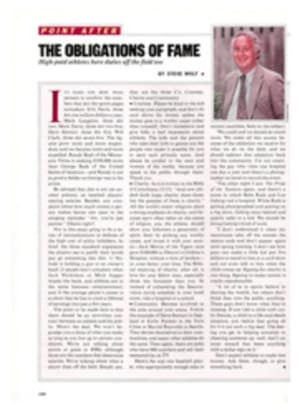
NEAT'S-FOOT OIL: A GLOVE'S BEST FRIEND
For years the springtime ritual of rubbing down my Brooks Robinson-signature glove with neat's-foot oil marked the beginning of my personal baseball season. On some snowy evening in late February or early March, my dad would turn away from his newspaper and say: "Isn't it time to dig out your mitt? We probably should get the leather softened up."
I was always eager to do something with my dad, but finding my glove after six months of football season and wrestling practices wasn't as simple as he made it sound. I wasn't one of those kids who kept his glove dangling from the post of his bed while he assembled his collection of baseball cards. In those days I considered myself the junior Jim Thorpe of New Jersey, and my baseball gear had to take its turn in rotation. It had to survive the great democracy at the back of my closet, a place where my navy blue first communion suit received no more respect than did my two-man pup tent.
When I finally found the glove, my dad would go to the kitchen, reach up beside the saltines and Campbell's tomato soup, and pull down a small tin of neat's-foot oil. The tin resembled a hip flask. We would spread newspapers over the kitchen table, find an old rag in the broom closet and begin the task of rubbing oil into leather.
It was a magical thing to do. My glove usually turned as dry and hard as a turtle's shell during its six months in the closet. The leather would crack and tighten. It remained clamped shut, almost as if preserving my last catch of the season. After the application of the oil, it became as soft as a dog's tongue.
I had forgotten about the ritual until a few months ago. After a move to a different state, I came across my old glove in the bottom of a cardboard box. Though I'm 36 now and mark the opening of trout season more carefully than the beginning of spring training, when I saw what pitiful condition the glove was in, I couldn't stick it back in the box. I pulled it out, hung it on a coat rack near the back door of our apartment in Concord, N.H., and went into town to find some neat's-foot oil.
What I learned in the course of the afternoon is that by asking for products you haven't used in 20 years, you can suffer cruelly at the hands of young salespeople. In the first sporting-goods store I visited, I found myself face-to-face with a young woman who was obviously a fitness buff. When I asked her for the oil, she began shaking her head before I finished.
"What is that stuff...nees foots?" she asked.
"Neat's-foot."
"Helen?" she called to another young woman. "You know anything about nees foots oil?"
"Neat's-foot," I corrected.
"Whatever.... Do you, Helen?"
"Never heard of it. What is it?"
"Leather conditioner," I told her, although it occurred to me that I had no idea what neat's-foot oil actually was. "I used to rub it on a baseball glove."
"No, we got nothing like that. We got mink oil, but that's mostly for boots...waterproofing, you know? We get some stuff in for mitts called Glovolium. Give us a month."
I pronounced "neat's-foot oil" very carefully five or six times before I was finished visiting sporting goods stores. Each time the clerk smiled at me. Each time I felt as if I had asked for something as ancient, and perhaps arcane, as Butch Wax. Crew cuts and flattops and neat's-foot oil. I should have been wearing saddle shoes.
I finally found it at United Shoe Repair. I knew I was in the right place when I walked in the door. The shop smelled like leather and neat's-foot oil. It smelled like a barn on a wet fall day. An elderly gentleman who was busy buffing an old brogan on a wire wheel pointed to a shelf as soon as I asked.
"Do you have any idea what this stuff is made of?" I asked him when I brought a small plastic bottle to the register.
"No, not really. The farmers used it on leather tack, harness and that sort of thing. It's still good for shoes. That'll be $2.75."
I stopped at the library on the way home and looked up neat's-foot oil. An encyclopedia described it as a pale yellow oil from the feet of neat—Old English for cattle. It is used in waterproofing and softening leather and as a lubricant for delicate machinery. It's made by boiling the hooves and shinbones of cattle. I liked the stuff for being natural, even if it did come in a plastic bottle instead of the tin container I remembered. I liked imagining my glove as a piece of a harness.
Nevertheless, I didn't like thinking of the world of baseball without neat's-foot oil. And how could its place in the world be taken by something called Glovolium, which sounded too much like linoleum and hinted strongly at a world going to ruin? I read on the bottle that this brand of neat's-foot was made by the Shoe Care division of Kiwi Brands, Inc., in Douglassville, Pa., so I called the company and talked to the product manager. He wasn't quite sure what neat's-foot oil was made from, but he said he would check with one of their chemists. The next day he called me back and began to read me a familiar definition: 'Neat's-foot oil is a pale yellow oil...." he started.
"I've got it, " I said.
He wasn't offended. He told me to check with Rawlings, and perhaps Louisville Slugger, to see if they were in the oil business.
From Rawlings I learned that the company had never actually produced neat's-foot oil, but that it did indeed issue the dreadfully named product Glovolium and had been doing so, to my surprise, for 75 years.
"Neat's-foot oil just softens leather," a manager told me. "We felt we needed something that waterproofed, conditioned and softened."
"Glovolium?" I asked.
"Yep, Glovolium. Actually, from what I hear, some of the pros use shaving cream."
Later, I spoke with Mark Proctor in Cincinnati, who owns a company called Accupack Midwest Inc. Proctor believes that Accupack is the biggest supplier of glove oil in the country. He provides Hillerich & Bradsby, the makers of Louisville Slugger bats, with Glove Oil Conditioner. Hillerich & Bradsby calls it, appropriately enough, Louisville Slugger Glove Softener. Proctor also provides Regent Sports with Baseball Glove Conditioner, which is a neat's-foot oil blend. He is quick to point out that most of the glove softeners are fairly similar: "The base for these oils might be neat's-foot oil, but they add a little something, a few more chemicals. It all does about the same thing. The trouble is, if you use nothing but neat's-foot oil, it will eventually turn the mitt a cream color. Most people don't go for that."
By rough count, he guessed that at least a million four-ounce bottles—a bottle should be enough for an entire season of play if used once every two weeks—of glove softener are purchased each year in America.
Rawlings, the leader in the American baseball glove market, sells somewhere in the vicinity of 50,000 to 75.000 four-ounce bottles of Glovolium, which also uses a neat's-foot oil base.
I asked Proctor if he'd ever heard of anyone using shaving cream on gloves.
"Yeah, I heard that," he said. "I've also heard that some phone company supposedly uses shaving cream on its underground cables to clean them. Me, I used Crisco on my mitt even when I played for the University of Cincinnati."
After I hung up the phone, I spread out a newspaper on the kitchen table and went to work on my old glove. It was dry, and it turned almost orange when I first applied the neat's-foot oil. I kept adding oil until the leather started to yield. It turned brown, then darker brown, like wood accepting stain. I poured a puddle into my palm, pried the wristband back, and slid my fingers inside. My hands were bigger than they had been when I was 17, and my fingertips extended the holes at the very ends of the leather channels. I massaged the leather and felt the palm print made by myself long ago slowly relax and disappear.
TWO ILLUSTRATIONS
GREG RAGLAND
Joseph Monninger's newest novel, "The Viper Tree, " will be published this fall.

